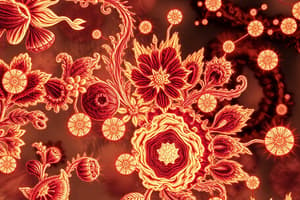Podcast
Questions and Answers
What was Hans Christian Gram searching for in 1884?
What was Hans Christian Gram searching for in 1884?
- A method to visualize Salmonella Typhi
- A method to visualize cocci in tissue sections (correct)
- A method to visualize Tubercle bacilli
- A method to visualize Streptococcus pneumoniae
What was used as the primary stain in Gram's method?
What was used as the primary stain in Gram's method?
- Iodine solution
- Turbercle bacilli
- Crystal Violet (Gentian Violet) (correct)
- Ethanol
What is the purpose of the Gram stain?
What is the purpose of the Gram stain?
- To differentiate organisms of the domain Bacteria according to cell wall structure (correct)
- To visualize Turbercle bacilli
- To study eukaryotic cells
- To identify bacteria associated with disease
What is the characteristic of Gram-positive cells?
What is the characteristic of Gram-positive cells?
What is the result of the Gram stain on Gram-negative cells?
What is the result of the Gram stain on Gram-negative cells?
What percentage of the cell wall is composed of peptidoglycan in Gram-positive bacteria?
What percentage of the cell wall is composed of peptidoglycan in Gram-positive bacteria?
What is the purpose of the decolorizing agent in the Gram staining procedure?
What is the purpose of the decolorizing agent in the Gram staining procedure?
Why do Gram-negative cells stain pink in the Gram staining procedure?
Why do Gram-negative cells stain pink in the Gram staining procedure?
What is the function of the primary stain (crystal violet) in the Gram staining procedure?
What is the function of the primary stain (crystal violet) in the Gram staining procedure?
Why is the Gram staining procedure not used for Archaea or Eukaryotes?
Why is the Gram staining procedure not used for Archaea or Eukaryotes?
Flashcards are hidden until you start studying
Study Notes
History of Gram Stain
- Hans Christian Gram developed the Gram stain in 1884 to visualize cocci in tissue sections of lungs of pneumonia patients.
- Gram's method was based on Robert Koch's staining method for visualizing tuberculosis bacilli.
- The Gram stain uses Crystal Violet as the primary stain, an iodine solution as a mordant, and ethanol as a decolorizer.
Purpose of Gram Stain
- The Gram stain is fundamental to the phenotypic characterization of bacteria.
- It differentiates organisms of the domain Bacteria according to cell wall structure.
Theory of Gram Stain
- The Gram stain is a complex and differential staining procedure.
- Gram-positive cells have a thick peptidoglycan layer and stain blue to purple.
- Gram-negative cells have a thin peptidoglycan layer and stain red to pink.
- The staining procedure is not used for Archeae or Eukaryotes as they lack peptidoglycan.
Gram Stain Procedure
- The Gram stain requires four basic steps: applying a primary stain, adding a mordant, rapid decolorization, and counterstaining.
- The performance of the Gram stain involves the use of crystal violet, Gram's Iodine, and a decolorizing agent.
Chemical Mechanism of Gram Stain
- Crystal violet dissociates into CV+ and Cl– ions that penetrate through the cell wall and membrane.
- The CV+ interacts with negatively charged components of bacterial cells, staining the cells purple.
- Iodine interacts with CV+ to form large CVI complexes within the cytoplasm and outer layers of the cell.
- The decolorizing agent interacts with the lipids of the membranes of both gram-positive and gram-negative bacteria.
Gram-Positive and Gram-Negative Bacteria
- Gram-positive bacteria have cell walls that contain thick layers of peptidoglycan (90% of cell wall) and stain purple.
- Gram-negative bacteria have cell walls with thin layers of peptidoglycan (10% of wall) and high lipid content, and stain pink.
- Gram-negative cells have a slightly different structure of peptidoglycan than gram-positive cells.
- With ethanol treatment, gram-negative cell walls become leaky and allow the large CV-I complexes to be washed from the cell.
Studying That Suits You
Use AI to generate personalized quizzes and flashcards to suit your learning preferences.




